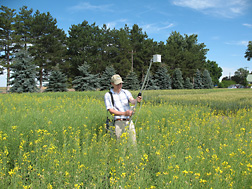ARS Researchers Flying Higher With New Jet Fuels
|
|
In 2011, U.S. airlines burned through nearly 19 billion gallons of fuel, which goes a long way in explaining the establishment of “FARM to FLY,” a partnership among the U.S. Department of Agriculture, Airlines for America, Inc., the Boeing Company, and others to advance the development and production of aviation biofuel. Work by ARS scientists and their university and industry partners will help ensure that this effort pays off.
ARS chemist Terry Isbell is managing the workflow for scientists and support staff throughout the 4-year project, which is funded by USDA’s National Institute of Food and Agriculture.
“We’re looking for the ideal plant oils—and the ways to produce them—for making hydrotreated renewable jet fuel,” Isbell says, who works in the ARS Bio-Oils Research Unit at the National Center for Agricultural Utilization Research in Peoria, Illinois. “By taking a complete supply-chain systems approach, we’ll be able to reduce the costs of these fuels and make them more competitive with petroleum jet fuel.”
Project scientists are looking for genetic traits in oilseeds that enhance fuel production and using those traits to develop new oilseed strains for biofuel. They are focusing on improving sustainable production practices for oilseed crops and streamlining methods for pre- and postharvest oilseed processing. Achieving these objectives will help increase grower profits, lower feedstock costs for biorefiners, and improve the efficiency of conversion of rapeseed, a type of oilseed, to jet fuel.
“Every 1-percent increase in efficiency we can achieve in the hydrotreated renewable-jet-fuel supply chain reduces the production cost of each gallon by 5 cents,” adds ARS national program leader Jeffrey Steiner, who assembled the project team and continues to participate in the research activities. “These costs savings can add up very quickly and could translate into significantly more business for agriculture.”
One Project, Many Options
To this end, Isbell and his colleagues will be cultivating varieties, experimental lines, and around 2,000 germplasm accessions of Brassica napus—industrial rapeseed, a nonfood variety of canola—in experimental trials in Arizona, California, Colorado, Idaho, Iowa, Minnesota, Montana, North Dakota, Oregon, and Texas. This will give scientists a range of oilseed material to work with as they assess how to maximize production and seed-oil yields for agricultural environments across the inland Pacific Northwest, the southern Great Plains Prairie Gateway, and the Northern Great Plains (See map in "ARS and the Regional Biomass Research Centers" article in this issue).
These sites are also prime production areas for U.S. wheat, so the researchers want to identify rapeseed/wheat rotation systems that don’t disrupt food-crop production for biofuel production. They will also be collecting information to see how rotating rapeseed in wheat fields could help reduce erosion, increase water-holding capacities, and reduce the need for herbicides, while increasing dependable supplies of oilseeds for production. The Navy’s Office of Naval Research is helping to fund this work.
ARS scientists Michael Gore and Matthew Jenks are working with University of Idaho plant breeder Jack Brown to sort through the genomes of each variety of rapeseed and find traits that can improve seed yield, oil yield, oil quality, and conversion efficiency of rapeseed oil to biofuel. The scientists will also identify traits that boost rapeseed tolerance to heat and cold, water stress, and other agronomic factors. Gore and Jenks work at the U.S. Arid-Land Agricultural Research Center in Maricopa, Arizona, and Jenks serves as coordinator for the Western Regional Center.
“This is a large testing population with tremendous trait variability, and the Brassica genome contains a significant amount of DNA variation at the population level,” says Gore. “So first we’ll sequence the thousands of genomic regions across individuals in the populations to catalog the extensive DNA variation. Then we’ll conduct statistical tests to identify associations between DNA variation and different traits. It will be like looking for the proverbial needle in a haystack with a magnifying glass.”
As part of this process, the researchers will work with Steve Lupton, Stan Frey, and others at Honeywell UOP to identify promising traits for biofuel processing. The ARS team will develop 1-gallon batches of bio-oil from the most promising oilseed candidates, and the UOP researchers will then assess the test fuels to determine which oilseed genetic lines produce oils with the most favorable traits for renewable jet fuel production.
“Once we’ve identified important genetic traits that improve fuel production from oilseeds—whether it’s in the crop field or in the biofuel production process—we’ll be able to apply the results to the entire jet fuel supply chain. Another benefit from our work is that these results can be applied to edible canola oil, which is a variety of rapeseed, and other crops that provide significant amounts of seed oil such as cotton,” says Jenks. “We’ll also use the ARS SoyBase genomics database in Ames, Iowa, as a model for developing a genetic information system for Brassica.”
Tools of the Trade
Dan Long, who works at the Columbia Plateau Conservation Research Center in Pendleton, Oregon, and serves as the Northwestern Regional Center coordinator, is taking remote-sensing tools with a proven track record and studying how they can be used to assess seed-oil quality and quantity before and after harvest. For more than 30 years, near infrared reflectance (NIR) spectroscopy has been used as a rapid, nondestructive technique for measuring protein, moisture, and oil levels in whole grains.
Long used a specialized in-line NIR sensor to assess seed-oil content in 226 canola samples obtained over 6 years from sites in Montana, Oregon, and Washington. Oil concentrations in the samples ranged from 32 percent to 46 percent, and he found that the NIR sensor was able to predict seed-oil content with an average error of 0.73 percent.
Seed-oil concentration is used to estimate extraction efficiency, which is the percentage of oil recovered in relation to the amount of oil in seed. Long believes that NIR sensors could be installed in seed-crushing facilities to rapidly and continuously measure the oil content of clean seed flowing into the expeller. Using NIR to monitor extraction efficiency might enable crushers to adjust the choke setting on the expeller to compensate for oil loss in meal. This would boost profits associated with seed processing and lower the costs of the oil feedstock that is converted into jet fuel.
NIR measurements could also help optimize the amount of acreage used to produce oilseed crops for biofuel. “We might be able to reduce the number of acres needed for biofuel feedstock production by maximizing seed-oil extraction rates in the seed-crushing facilities,” Long explains. “And NIR sensing could be used to segregate the seed entering the plant into groups with low, intermediate, or high oil content. Each group could be processed at different times, depending on market demand.”
Long will also be using NIR information from aerospace remote sensing to predict oilseed traits desired by UOP and evaluate how within-field variability affects seed-oil characteristics and quality. And since some crushing facilities pay a premium to growers for maximizing the oil concentration of their oilseed crops, a NIR instrument mounted on a GPS-equipped combine would give growers the ability to map fields according to oil concentrations in the seeds and estimate the subsequent dollar value of the crops.
Taking Care of Business
The Navy Office of Naval Research is also funding an assessment of the infrastructure needed to support production and transport of the jet fuel, with help from the U.S. Department of Transportation’s Volpe National Transportation Systems Center in Cambridge, Massachusetts. Agricultural economist Dave Archer, who works at the ARS Northern Great Plains Research Laboratory in Mandan, North Dakota, is helping to develop decision tools to find the most sustainable ways to grow oilseed crops that also minimize greenhouse gas production and reduce negative impacts on wheat markets and water quality. And business developer Terry Tomlinson, who works at the National Feedstock Resource Center in Enid, Oklahoma, will help expand business networks via meetings with growers and other commodity partners who could contribute resources toward successful development of biofuel chains.
“From start to finish, we want to provide the information that industry and agriculture will need to support hydrotreated renewable jet fuel production,” Isbell says. “These are new crops for many farmers, and it’s important for them to know that if they make a switch, they can still turn a profit. In the end, we want results that are adopted and useful—and that lead to biofuels for commercial and military aircraft.”—By Ann Perry, Agricultural Research Service Information Staff.
To reach scientists mentioned in this article, contact Ann Perry, USDA-ARS Information Staff, 5601 Sunnyside Ave., Beltsville, MD 20705-5129; (301) 504-1628.
The ARS locations included in this story are part of USDA’s Regional Biomass Research Centers (RBRC) network. The RBRC is made up of five national centers whose mission is to help accelerate the establishment and production of sustainable commercial biomass from farms and forests without disrupting the production and marketing of food, feed, and fiber.
"ARS Researchers Flying Higher With New Jet Fuels" was published in the September 2012 issue of Agricultural Research magazine.








